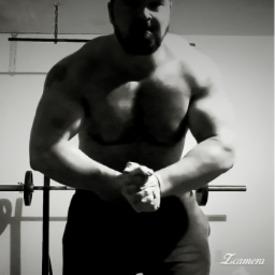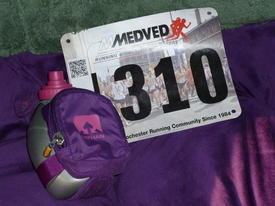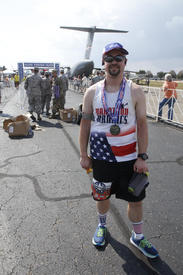Sprinting is so much better,
Replies
-
SonicDeathMonkey80 wrote: »I think that might be right. One thing elite runners try to do is to glide over the ground -- that is, to stay light on their feet. When you jog slowly, you thud and plop. Every step is a hard step onto the ground. It is much easier to skim when you are going fast. Your feet reach out when you are going fast, and then they grab the earth and push it behind without really landing...at least, not so much.
Speed doesn't always influence form. A good runner can maintain good form/cadence no matter what the speed.
Oh c'mon now people! We've been over this. I am not saying it is wrong or it is right. I am just saying it is easier to be up on your forefoot when moving fast. You almost have to get up on your forefoot. And, right or wrong, lots of people do land with their heal when running slowly. I find there is more pounding when I land on my heals and when I am going slowly. I expect that is fairly universal.
Really, now.....
0 -
I disagree that you cannot learn a new running form. A couple of years ago I was a heel striker and was suffering the usual low grade constant knee pains from running. I retaught myself midfoot striking and overall good form and have completely eliminated all pain. Plus, I have tried and I cannot heel strike and overstride anymore without a huge effort that feels totally unnatural.
I am pretty sure that research has shown that it is quite difficult to get a heal/midfoot striker to change their running style.
But, here is a webpage that seems to say they can.
http://www.barefootrunning.fas.harvard.edu/5BarefootRunning&TrainingTips.html
0 -
I don't know, nor do I care about any of the form stuff being argued here...I just prefer sprinting. I was a sprinter/jumper from 2nd grade through high school graduation. I've never been a good distance runner, even at my height of conditioning in the military...but I was at one point ranked 3rd in the State of New Mexico in the 100 meters.
Some people are runners and some people are sprinters.0 -
Compressive forces on the joints are much greater during jogging than they are during sprinting for a lot of people who aren't built well for long, slow runs so what OP is saying makes sense. Personally, I can't jog for long without my ankles and knees killing me but I can run sprints without any issues at all, especially if I run hill sprints.0
-
I enjoy sprinting intervals mixed with my jogging as it really pushes my heart rate up and its having a super fat burning effect
 0
0 -
SonicDeathMonkey80 wrote: »I think that might be right. One thing elite runners try to do is to glide over the ground -- that is, to stay light on their feet. When you jog slowly, you thud and plop. Every step is a hard step onto the ground. It is much easier to skim when you are going fast. Your feet reach out when you are going fast, and then they grab the earth and push it behind without really landing...at least, not so much.
Speed doesn't always influence form. A good runner can maintain good form/cadence no matter what the speed.
Oh c'mon now people! We've been over this. I am not saying it is wrong or it is right. I am just saying it is easier to be up on your forefoot when moving fast. You almost have to get up on your forefoot. And, right or wrong, lots of people do land with their heal when running slowly. I find there is more pounding when I land on my heals and when I am going slowly. I expect that is fairly universal.
Really, now.....
Then it should also be noted that when learning proper running form, it's been taught that a runner should have a slight lean forwards, which encourages a forefoot strike....who else leans forwards while running? Sprinters! Practicing proper form (leaning, increaseing the cadence, not crossing the midsection with your arm swing, etc) all minimize injury. Emphasis on the the word Practice. And I find my form worsens if I try to run faster than my body has trained for (read:heel striking and "ploding" along).
that being said, I agree with the poster above-some people spring and some people run long distance. Do what works for you.0 -
It really boils down to how you enjoy training and what your goals are. If you simply enjoy sprinting, then yes sprinting is awesome. If you need to train your anaerobic capacity then you definitely need to do some sprinting. If you need to work on aerobic capacity then you need some longer distance running. I don't know that sprinting or jogging is any better / worse on your knees. Speed is largely about ground force contact in that the more force you apply to the ground the faster you will move. When you apply that force that's going to transfer up into your body, so I'm not sure one is any healthier than the other in that regard. I for one would rather look like a sprinter than a marathon runner, that's for sure.0
-
I'm a newbie runner and just did my first 5K last Sat. (my profile pic is from that and my time was 30:00 exactly). Six months ago, I couldn't run more than 200 feet without having to stop.
My biggest challenge was pace. When I go out on the street, I don't know how to pace myself and I end up going way too fast. So I have to stop or slow down to a walking pace for too long.
So I learned that running doesn't need to be sprinting and I started training on a treadmill because it was cold outside and because I could set the pace instead of unknowingly going way too fast. I did that for a month or so and increased how long I could run.
But then it warmed up and I went outside a couple weeks ago. The same thing happened... I ran too fast and then had to slow down and walk. The thing I noticed was that I had a better total time doing this. So I just decided to embrace it... go at the speed I was comfortable with, keep going as long as I possibly could, and then slow down and walk. Over time, I believe I'll be able to go a whole 5K without walking at all.
Just in case you are wondering, I use Runkeeper to track so I can go back and see how fast I'm going and for how long. My typical sprints are between 9.5-10 mph and lasted for 1-2 minutes at first. Last night, I went out for a short (1.75 miles) run. The first mile averaged out to 8.43 mph and the 2nd mile (3/4 mile) was at 7.31 mph. There was some walking in the first mile, and even more walking in the 2nd partial mile. As I do this more, I find I can keep sprinting for longer, which means I walk less and increase my average time per mile.0 -
While this seems like a logical way to get faster it won't work for long. While sprinting you are not building the aerobic system which in any race over 800 m is the predominant system providing your energy. Even in a 5K 90% of the energy is provided aerobically and only 10% anaerobically. So what you are doing is working the 10% and neglecting the 90%.midwesterner85 wrote: »I'm a newbie runner and just did my first 5K last Sat. (my profile pic is from that and my time was 30:00 exactly). Six months ago, I couldn't run more than 200 feet without having to stop.
My biggest challenge was pace. . ; ; As I do this more, I find I can keep sprinting for longer, which means I walk less and increase my average time per mile.
You need to run mostly long and easy to build the aerobic system. If you are having trouble with pace and have a HRM keep your HR under about 77% max. If you don't have a HRM then stay below the ventilatory threshold (before you start breathing hard).
Sprint once a week.
0 -
midwesterner85 wrote: »But then it warmed up and I went outside a couple weeks ago. The same thing happened... I ran too fast and then had to slow down and walk. The thing I noticed was that I had a better total time doing this. So I just decided to embrace it... go at the speed I was comfortable with, keep going as long as I possibly could, and then slow down and walk. Over time, I believe I'll be able to go a whole 5K without walking at all.
You'll get to a faster 5k, faster, by running long and slow than you will by run/walking. Sprinting, running, walking - they all have different physiological effects. The changes you want for a "good" 5K will only come from running 5K (and up).
Sprinting generates about 2x the physical force through the foot as does normal running. Whether that's harder or easier on any particular body will depend on the body - some folks are built for speed, others are built for distance. Most are in-between.
0 -
slow jogging might be more stressful on the joint overtime (although I have not experienced this), but sprinting flat out (Tabata/HIIT type stuff) might lead to muscle tears (Hamstrings, groin, acillies etc). So make sure to warm up properly and stretch before flat out sprinting. Common sense.0
-
I sprint when I do HIIT intervals on the treadmill. I run at 7.5 for 20 secs/jump onto the siderails to rest 10 secs for 8 rounds. It doesn't hurt to run slowly, though. I just get tired after about 5 minutes. I really like sprinting.0
-
Lots of valuable info here! I think sprinting may feel better because of how I train. My daily training is filled with short 5-15min HITs ("not wiped out" but "pushed") And I play tennis which is also a lot of bursts. I run trails ( hills, obstacles...) changing it up with short bursts. No problem.
I can jog over 10 minutes without getting winded. But the pain must be that my tibias aren't ready for long distance. Patience. Form. It's an art. You runners are awesome!
0 -
While this seems like a logical way to get faster it won't work for long. While sprinting you are not building the aerobic system which in any race over 800 m is the predominant system providing your energy. Even in a 5K 90% of the energy is provided aerobically and only 10% anaerobically. So what you are doing is working the 10% and neglecting the 90%.midwesterner85 wrote: »I'm a newbie runner and just did my first 5K last Sat. (my profile pic is from that and my time was 30:00 exactly). Six months ago, I couldn't run more than 200 feet without having to stop.
My biggest challenge was pace. . ; ; As I do this more, I find I can keep sprinting for longer, which means I walk less and increase my average time per mile.
You need to run mostly long and easy to build the aerobic system. If you are having trouble with pace and have a HRM keep your HR under about 77% max. If you don't have a HRM then stay below the ventilatory threshold (before you start breathing hard).
Sprint once a week.
I do us a HRM usually and yesterday's run, which was pretty short, gave me an average BPM of 138. There was obviously some fluctuation, but it was only about 14 min. and 10 min. of that was pretty close to the average. I believe that is slightly under 77% of my max.0 -
Yeah, try to mix things up. Both are great and functional for real life and its great to test both your aerobic and anaerobic functions. I run 100m in 11.3 seconds and can run 10 mile in 60 min. Both are excellent forms of cardio but should not be considered mutually exclusive and being fairly competent at both should be considered as a goal rather than one compromising the other. However, do what you enjoy as that will be more sustainable.0
-
SonicDeathMonkey80 wrote: »I think that might be right. One thing elite runners try to do is to glide over the ground -- that is, to stay light on their feet. When you jog slowly, you thud and plop. Every step is a hard step onto the ground. It is much easier to skim when you are going fast. Your feet reach out when you are going fast, and then they grab the earth and push it behind without really landing...at least, not so much.
Speed doesn't always influence form. A good runner can maintain good form/cadence no matter what the speed.
Oh c'mon now people! We've been over this. I am not saying it is wrong or it is right. I am just saying it is easier to be up on your forefoot when moving fast. You almost have to get up on your forefoot. And, right or wrong, lots of people do land with their heal when running slowly. I find there is more pounding when I land on my heals and when I am going slowly. I expect that is fairly universal.
Really, now.....
Maybe I'm a snowflake, but I front-strike regardless of whether I'm doing 5:00-paced strides or a 12:00 mile. Speed is no excuse for poor form.0 -
SonicDeathMonkey80 wrote: »I think that might be right. One thing elite runners try to do is to glide over the ground -- that is, to stay light on their feet. When you jog slowly, you thud and plop. Every step is a hard step onto the ground. It is much easier to skim when you are going fast. Your feet reach out when you are going fast, and then they grab the earth and push it behind without really landing...at least, not so much.
Speed doesn't always influence form. A good runner can maintain good form/cadence no matter what the speed.
Oh c'mon now people! We've been over this. I am not saying it is wrong or it is right. I am just saying it is easier to be up on your forefoot when moving fast. You almost have to get up on your forefoot. And, right or wrong, lots of people do land with their heal when running slowly. I find there is more pounding when I land on my heals and when I am going slowly. I expect that is fairly universal.
Really, now.....
I like the last bolded part where you start addressing what you do rather than talk about how runners should, could, would run.
0 -
All you MFPers have made me want to run. And I suck at it! But, I'm learning. And, I am finding, jogging at a slow pace seems more painful on the shins than sprinting (treadmill or street). Am I right? What is your experience?
Your experience doesn't make sense to me. Why would any pace be painful for your shin? To me that happens when I'm injured or asking for trouble.0 -
All you MFPers have made me want to run. And I suck at it! But, I'm learning. And, I am finding, jogging at a slow pace seems more painful on the shins than sprinting (treadmill or street). Am I right? What is your experience?
Your experience doesn't make sense to me. Why would any pace be painful for your shin? To me that happens when I'm injured or asking for trouble.
Happens to me, as well. It typically means there is overactivity in the musculature around the shin. I can roll it out and stretch before a jog or walk and I’m usually ok. It is seldom an issue if I’m running, which has me on the ball of my foot rather than my heels.
0 -
I almost hesitate to say this, since there seems to be some pretty defensive posturing about heel striking. But I would think a new runner, someone who is just starting out, would be better served by working on proper form, leaning forward and forefoot striking, while also working on achieving a cadence long term of 180 strides/minute. Sure, they may feel natural overstriding with a heel strike and can even slowly develop into fine runners doing so. Many people have run great distances for many years with long strides and they are not complaining. But why learn to run that way when you could simply learn to do it the safer way (safer in terms of just starting out and not having strong bones/ligaments, not for experienced runners who can withstand it).0
-
Also, about "prancing about tippie-toe running", that is taking proper form to the opposite extreme for distance running, really. I bookmarked this video some time ago when I was studying form. Maybe it will be informative for some. The thing is, you do not need to run up on your toes as high as a sprinter, but you probably could avoid a heel strike if you are new and work on a mid to forefoot strike.
 https://www.youtube.com/watch?v=--YU8YcWeUU
https://www.youtube.com/watch?v=--YU8YcWeUU
0 -
AllanMisner wrote: »All you MFPers have made me want to run. And I suck at it! But, I'm learning. And, I am finding, jogging at a slow pace seems more painful on the shins than sprinting (treadmill or street). Am I right? What is your experience?
Your experience doesn't make sense to me. Why would any pace be painful for your shin? To me that happens when I'm injured or asking for trouble.
Happens to me, as well. It typically means there is overactivity in the musculature around the shin. I can roll it out and stretch before a jog or walk and I’m usually ok. It is seldom an issue if I’m running, which has me on the ball of my foot rather than my heels.
I loved the bolded part where it seems you have learnt to "master the art " to fix the issue. 0
0 -
Foam rollers and LaCrosse balls are my friends
 0
0 -
slideaway1 wrote: »Yeah, try to mix things up. Both are great and functional for real life and its great to test both your aerobic and anaerobic functions. I run 100m in 11.3 seconds and can run 10 mile in 60 min. Both are excellent forms of cardio but should not be considered mutually exclusive and being fairly competent at both should be considered as a goal rather than one compromising the other. However, do what you enjoy as that will be more sustainable.
Is that laser timed, or just rough with a stop watch? If laser, and you're interested, you should join your local athletics club, you could probably win the British championships at your masters age group with that time, assuming no ex-Olympians decide to enter. Also, its safe for me to suggest this, because my age gap is enough that we will rarely be in the same age category!!!
0 -
I only skimmed the form arguments, but there is most certainly a difference in form between sprinting and "jogging". That difference for the OP could be enough to cause pain while running slow but not while sprinting. Although it seems a little counter intuitive, its really not that far fetched.0
This discussion has been closed.
Categories
- All Categories
- 1.4M Health, Wellness and Goals
- 398.2K Introduce Yourself
- 44.7K Getting Started
- 261K Health and Weight Loss
- 176.4K Food and Nutrition
- 47.7K Recipes
- 233K Fitness and Exercise
- 462 Sleep, Mindfulness and Overall Wellness
- 6.5K Goal: Maintaining Weight
- 8.7K Goal: Gaining Weight and Body Building
- 153.5K Motivation and Support
- 8.4K Challenges
- 1.4K Debate Club
- 96.5K Chit-Chat
- 2.6K Fun and Games
- 4.8K MyFitnessPal Information
- 12 News and Announcements
- 21 MyFitnessPal Academy
- 1.6K Feature Suggestions and Ideas
- 3.2K MyFitnessPal Tech Support Questions

















